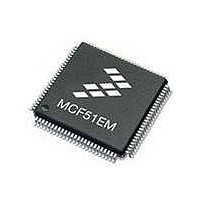MCF51EM256CLL Freescale Semiconductor, MCF51EM256CLL Datasheet - Page 277

MCF51EM256CLL
Manufacturer Part Number
MCF51EM256CLL
Description
IC MCU 32BIT 256KB FLASH 100LQFP
Manufacturer
Freescale Semiconductor
Series
MCF51EMr
Datasheets
1.MCF51EM128CLL.pdf
(2 pages)
2.MCF51EM128CLL.pdf
(54 pages)
3.MCF51EM128CLL.pdf
(636 pages)
Specifications of MCF51EM256CLL
Core Processor
Coldfire V1
Core Size
32-Bit
Speed
50MHz
Connectivity
I²C, SCI, SPI
Peripherals
LCD, LVD, PWM, WDT
Number Of I /o
63
Program Memory Size
256KB (256K x 8)
Program Memory Type
FLASH
Ram Size
16K x 8
Voltage - Supply (vcc/vdd)
1.8 V ~ 3.6 V
Data Converters
A/D 16x12b
Oscillator Type
External
Operating Temperature
-40°C ~ 85°C
Package / Case
100-LQFP
Processor Series
MCF51EM
Core
ColdFire V1
Data Bus Width
32 bit
Data Ram Size
16 KB
Interface Type
RS-232, LIN
Maximum Clock Frequency
50 MHz
Number Of Timers
3
Operating Supply Voltage
1.8 V to 3.6 V
Maximum Operating Temperature
+ 85 C
Mounting Style
SMD/SMT
3rd Party Development Tools
JLINK-CF-BDM26, EWCF
Development Tools By Supplier
DEMOEM
Minimum Operating Temperature
- 40 C
Lead Free Status / RoHS Status
Lead free / RoHS Compliant
Eeprom Size
-
Lead Free Status / Rohs Status
Lead free / RoHS Compliant
Available stocks
Company
Part Number
Manufacturer
Quantity
Price
Company:
Part Number:
MCF51EM256CLL
Manufacturer:
FREESCALE
Quantity:
110
Company:
Part Number:
MCF51EM256CLL
Manufacturer:
Freescale Semiconductor
Quantity:
10 000
- Current page: 277 of 636
- Download datasheet (11Mb)
12.2
The SPI optionally shares four port pins. The function of these pins depends on the settings of SPI control
bits. When the SPI is disabled (SPE = 0), these four pins revert to being general-purpose port I/O pins that
are not controlled by the SPI.
12.2.1
When the SPI is enabled as a slave, this pin is the serial clock input. When the SPI is enabled as a master,
this pin is the serial clock output.
12.2.2
When the SPI is enabled as a master and SPI pin control zero (SPC0) is 0 (not bidirectional mode), this
pin is the serial data output. When the SPI is enabled as a slave and SPC0 = 0, this pin is the serial data
input. If SPC0 = 1 to select single-wire bidirectional mode, and master mode is selected, this pin becomes
the bidirectional data I/O pin (MOMI). Also, the bidirectional mode output enable bit determines whether
the pin acts as an input (BIDIROE = 0) or an output (BIDIROE = 1). If SPC0 = 1 and slave mode is
selected, this pin is not used by the SPI and reverts to being a general-purpose port I/O pin.
12.2.3
When the SPI is enabled as a master and SPI pin control zero (SPC0) is 0 (not bidirectional mode), this
pin is the serial data input. When the SPI is enabled as a slave and SPC0 = 0, this pin is the serial data
output. If SPC0 = 1 to select single-wire bidirectional mode, and slave mode is selected, this pin becomes
the bidirectional data I/O pin (SISO) and the bidirectional mode output enable bit determines whether the
pin acts as an input (BIDIROE = 0) or an output (BIDIROE = 1). If SPC0 = 1 and master mode is selected,
this pin is not used by the SPI and reverts to being a general-purpose port I/O pin.
12.2.4
When the SPI is enabled as a slave, this pin is the low-true slave select input. When the SPI is enabled as
a master and mode fault enable is off (MODFEN = 0), this pin is not used by the SPI and reverts to being
a general-purpose port I/O pin. When the SPI is enabled as a master and MODFEN = 1, the slave select
output enable bit determines whether this pin acts as the mode fault input (SSOE = 0) or as the slave select
output (SSOE = 1).
Freescale Semiconductor
External Signal Description
SPSCK — SPI Serial Clock
MOSI — Master Data Out, Slave Data In
MISO — Master Data In, Slave Data Out
SS — Slave Select
BUS CLOCK
MCF51EM256 Series ColdFire Integrated Microcontroller Reference Manual, Rev. 8
SPPR2:SPPR1:SPPR0
1, 2, 3, 4, 5, 6, 7, or 8
Figure 12-3. SPI Baud Rate Generation
PRESCALER
DIVIDE BY
2, 4, 8, 16, 32, 64, 128, 256, or 512
SPR3:SPR2:SPR1:SPR0
CLOCK RATE DIVIDER
DIVIDE BY
8-bit Serial Peripheral Interface (SPI)
MASTER
SPI
BIT RATE
12-5
Related parts for MCF51EM256CLL
Image
Part Number
Description
Manufacturer
Datasheet
Request
R

Part Number:
Description:
BOARD DEMO HARDWARE ONLY
Manufacturer:
Freescale Semiconductor
Datasheet:

Part Number:
Description:
IC MCU 32BIT 128KB FLASH 100LQFP
Manufacturer:
Freescale Semiconductor
Datasheet:

Part Number:
Description:
IC MCU 32BIT 128KB FLASH 80LQFP
Manufacturer:
Freescale Semiconductor
Datasheet:

Part Number:
Description:
IC MCU 32BIT 256KB FLASH 80LQFP
Manufacturer:
Freescale Semiconductor
Datasheet:
Part Number:
Description:
Manufacturer:
Freescale Semiconductor, Inc
Datasheet:
Part Number:
Description:
Manufacturer:
Freescale Semiconductor, Inc
Datasheet:
Part Number:
Description:
Manufacturer:
Freescale Semiconductor, Inc
Datasheet:
Part Number:
Description:
Manufacturer:
Freescale Semiconductor, Inc
Datasheet:
Part Number:
Description:
Manufacturer:
Freescale Semiconductor, Inc
Datasheet:
Part Number:
Description:
Manufacturer:
Freescale Semiconductor, Inc
Datasheet:
Part Number:
Description:
Manufacturer:
Freescale Semiconductor, Inc
Datasheet:
Part Number:
Description:
Manufacturer:
Freescale Semiconductor, Inc
Datasheet:
Part Number:
Description:
Manufacturer:
Freescale Semiconductor, Inc
Datasheet:
Part Number:
Description:
Manufacturer:
Freescale Semiconductor, Inc
Datasheet:











